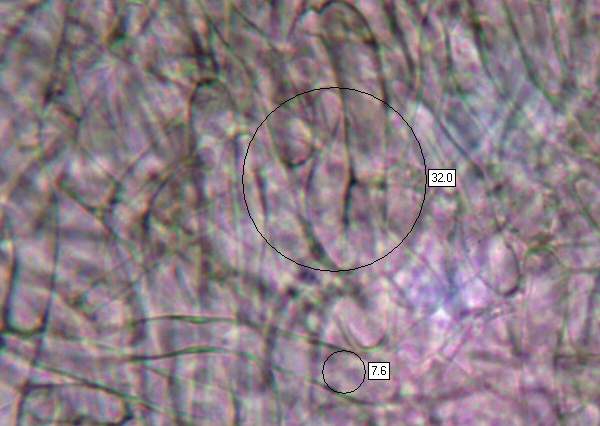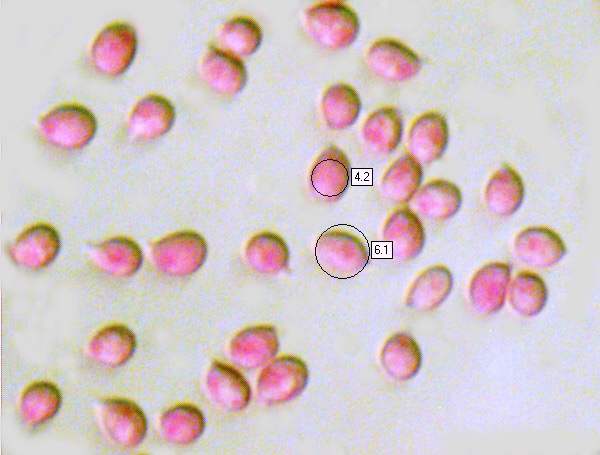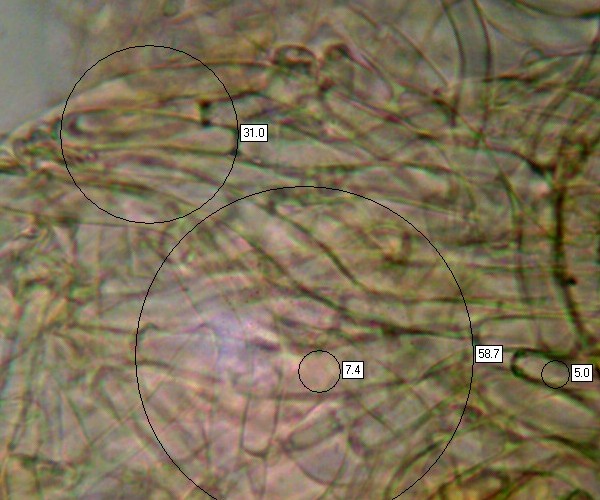Cuphophyllus (Hygrocybe) pratensis (Pers.) Murrill - Meadow Waxcap
Phylum: Basidiomycota - Class: Agaricomycetes - Order: Agaricales - Family: Hygrophoraceae
Distribution - Taxonomic History - Etymology - Identification - Culinary Notes - Reference Sources
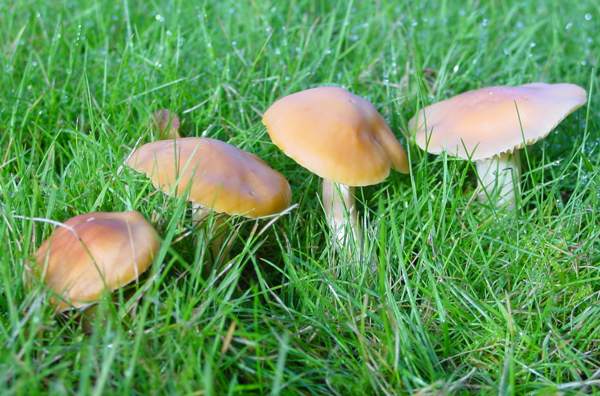
One of the largest of the waxcap fungi, and commonly known as the Meadow Wax cap, Cuphophyllus pratensis is a common find on cropped grassland and upland pastures. It appears from late August until December and is generally considered edible although not highly prized.
In some fairly recent field guides you may find this species listed under one of its many synonyms, which include Hygrocybe pratensis, Camarophyllus pratensis and Hygrophorus pratensis.
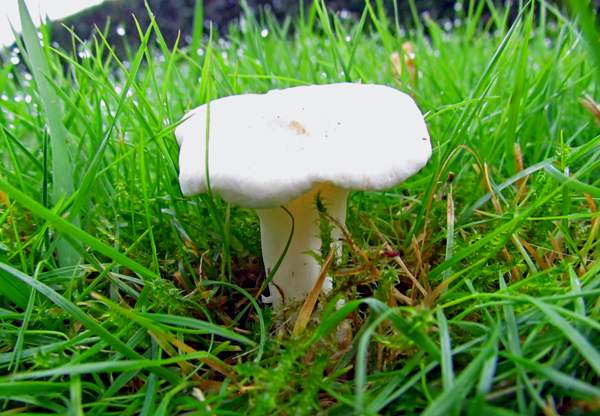
Above: the pure white variety of Meadow Waxcap, Hygrocybe pratensis var. pallida
Distribution
Widespread and fairly common in Britain and Ireland, particularly in upland areas on acidic soil, the Meadow Waxcap is one of the few Hygrocybe species that can tolerate small amounts of fertiliser being applied to its grassland habitat. The Meadow Waxcap often forms small groups or lines of mushrooms but also occurs as widely scattered singletons.
A pure white variety of the Meadow Waxcap occurs. Hygrocybe pratensis var. pallida (Cooke) Arnolds is very rare. You may find this waxcap recorded as Hygrocybe pallida, Hygrocybe ortonii or one of several other synonyms. In the USA it is commonly cited as Hygrocybe berkeleyi. Apart from colour, in all macroscopic and microscopic characters the white form is the same as the coloured form of Cuphophyllus pratensis. The dry and fibrous, flattening cap tops of Hygrocybe pratensis var. pallida are distinctive, and if the caps of Hygrocybe virginea, the Snowy Waxcap, always had translucent edges then differentiating between the two would not be difficult, but a dry old Snowy Waxcap could perhaps be mistaken for what some people call the White Meadow Waxcap. We found the specimen shown above in an orchard at Mount Stuart, on the Isle of Bute in western Scotland. (Intermediate white forms with pinkish-centred caps are quite common.)
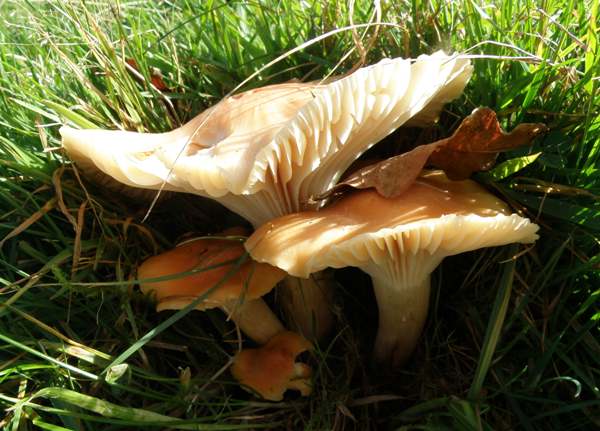
Taxonomic history
Although earlier naturalists had described the Meadow Waxcap - for example in 1796 the Shropshire botanist William Withering (1741-1799) described this grassland waxcap and called it Agaricus claviformis - it was Christiaan Hendrik Persoon who, when describing this species in his milestone publication Synopsis Methodicae Fungorum of 1801, created its basionym by naming it Agaricus pratensis. (In those days most gilled mushrooms were included initially in the genus Agaricus; the vast majority of them have since been redistributed to many other genera.)
It was not until 1914 that the famous American mycologist William Alphonso Murrill (1869 - 1957), writing in the journal Mycologia, transferred this waxcap to the genus Hygrocybe, establishing the scientific name as Hygrocybe pratensis. In 1985 this species was transferred to the genus Cuphophyllus by French mycologist Marcel Bon, and the name Cuphophyllus pratensis has since become its generally accepted scientific name.
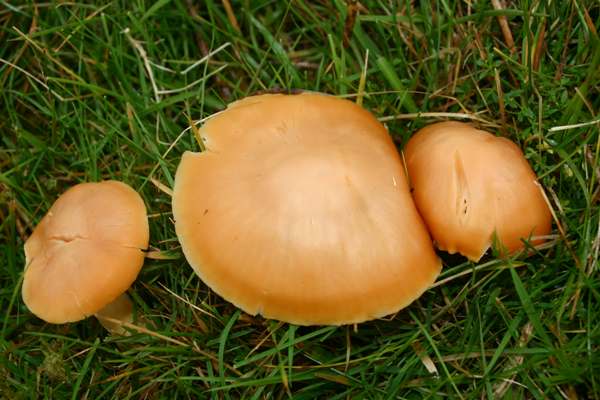
Two varieties of the Meadow Waxcap occur in Britain. The nominate form Cuphophyllus pratensis var. pratensis, pictured above and at the top of this page, and described in detail below, has a peach-coloured cap and stem, while Cuphophyllus pratensis var. pallida (also pictured second from top of this page) is pure white.
Being a large, conspicuous, attractive and edible mushroom, Cuphophyllus pratensis has caught the eye of many great mycologists down the ages. As a result it has acquired several synonyms including Agaricus pratensis (Pers. Gymnopus pratensis (Pers.) Gray, Hygrophorus pratensis (Pers.) Fr., Camarophyllus pratensis (Pers.) P. Kumm., and Hygrocybe pratensis (Pers.) Murrill.
Etymology
The genus Cuphophyllus was described in 1985 by French mycologist Marcel Bon. The prefix Cupho- means curved, while the suffix -phyllus refers to the leaves (gills) of mushrooms in this genus - so we arrive at 'with curved gills'. (Its former genus Hygrocybe is so named because fungi in this group are always very moist. Hygrocybe means 'watery head'.)
As a specific epithet pratensis is much easier to fathom out provided you have had a basic grounding in Latin. For those who have not, you will nevertheless be unsurprised to know that it it translates to 'of meadows'. That's where these chunky waxcaps are most often found.
Identification guide
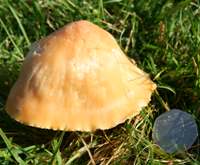 |
CapThe cap is slightly umbonate, 2 to 7cm in diameter and variable in colour from pale yellowish to buff or sometimes pinkish-red. Apart from during rain, the caps feel dry and smooth. As the fungus ages so the cap fades and its flesh turns from white to a pinkish buff. |
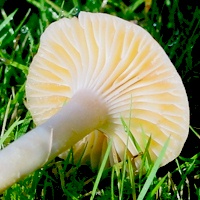 |
GillsThick, broad and distant, the cross-connected whitish gills of Hygrocybe pratensis are decurrent - often extending more than 1cm down the stem.. With age the gills become more cap coloured. StemWhite at first and later cap coloured, the solid stem of the Meadow Waxcap is stout and becomes hollow with age. |
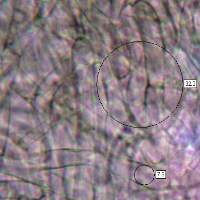 |
Gill tramaInterwoven or branched hyphal elements 25 - 210μm long x 5 - 11μm diameter. |
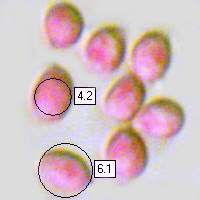 |
SporesEllipsoidal or teardrop-shaped to subglobose, smooth; 5.5-7 x 3.5-5μm. Spore printWhite. |
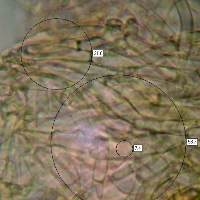 |
PilleipellisA cutis with some trichoderm-like elements. typically 25 - 60μm long and 5 - 10μm in diameter. |
Odour/taste |
Not distinctive. |
Habitat & Ecological role |
Closely mown grassland where artificial fertilisers have not been spread in large quantities (although this waxcap will tolerate small amounts of fertiliser), and in some sheep-cropped upland pastures, notably near roadsides. Waxcaps have long been considered to be saprobic on the dead roots of grasses and other grassland plants, but it is now considered likely that there is some kind of mutual relationship between waxcaps and mosses. |
Season |
August to December in Britain and Ireland. |
Similar species |
Porpolomopsis calyptriformis has a pink pointed cap and the cap invariably splits as it expands. |
Culinary Notes
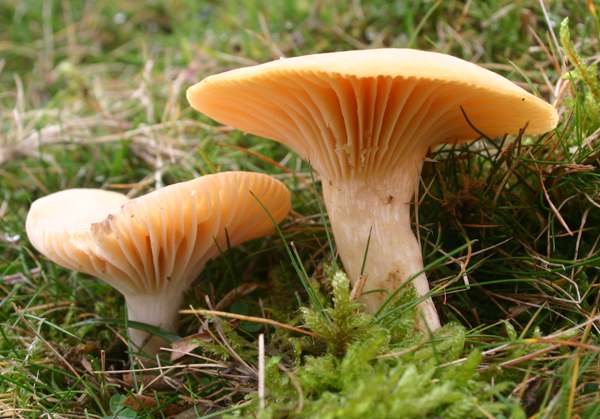
On a Europe-wide scale most waxcap fungi are now quite rare, and so although in western Britain many of the acid-soil species are still plentiful most mycologists deplore the suggestion of these lovely fungi being gathered to eat. Nevertheless, the Meadow Waxcap is quite well known as an edible mushroom, and in areas where there are enough of these fruitbodies to make collecting them worthwhile there are a few fungiphages who rate them very highly indeed.
Being fleshy and containing plenty of moisture (the latter a characteristic of waxcaps), Meadow Waxcaps can be fried in their own juices. Simply drop them into a hot pan with a bit of salt and pepper; there is no need to add fat or oil. When young and fresh the texture is firm, and so these wild mushrooms are good served with either meat or fish dishes.
One other plus point for this grassland mushroom (in its var pratensis form shown immediately above, of course, not the very rare var. pallida) is that it is difficult to confuse it with any of the poisonous gilled fungi that you are likely to find well away from trees.
Reference Sources
Fascinated by Fungi, 2nd Edition, Pat O'Reilly 2016, reprinted by Coch-y-bonddu Books in 2022.
Fungi of Northern Europe, Volume 1 - The Genus Hygrocybe, David Boertmann, 2010.
Dictionary of the Fungi; Paul M. Kirk, Paul F. Cannon, David W. Minter and J. A. Stalpers; CABI, 2008
Taxonomic history and synonym information on these pages is drawn from many sources but in particular from the British Mycological Society's GB Checklist of Fungi.
Fascinated by Fungi. Back by popular demand, Pat O'Reilly's best-selling 450-page hardback book is available now. The latest second edition was republished with a sparkling new cover design in September 2022 by Coch-y-Bonddu Books. Full details and copies are available from the publisher's online bookshop...
